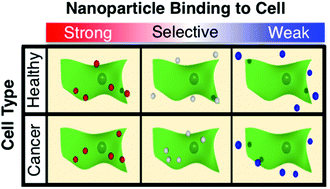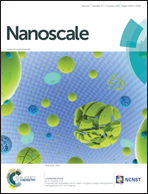Computational design of nanoparticle drug delivery systems for selective targeting†
Abstract
Ligand-functionalized nanoparticles capable of selectively binding to diseased versus healthy cell populations are attractive for improved efficacy of nanoparticle-based drug and gene therapies. However, nanoparticles functionalized with high affinity targeting ligands may lead to undesired off-target binding to healthy cells. In this work, Monte Carlo simulations were used to quantitatively determine net surface interactions, binding valency, and selectivity between targeted nanoparticles and cell surfaces. Dissociation constant, KD, and target membrane protein density, ρR, are explored over a range representative of healthy and cancerous cell surfaces. Our findings show highly selective binding to diseased cell surfaces can be achieved with multiple, weaker affinity targeting ligands that can be further optimized by varying the targeting ligand density, ρL. Using the approach developed in this work, nanomedicines can be optimally designed for exclusively targeting diseased cells and tissues.


 Please wait while we load your content...
Please wait while we load your content...